Winter Salads
Although it is relatively easy to grow leaves for winter consumption, most of the plants used in conventional gardening tend to be annuals (such as cabbage or spinach) and are also nicer when cooked. There are relatively few well known winter salad leaves and many of these (such as winter lettuce) require protection in all but mild winters. We would like to look at a few alternative winter salad plants and how they can be grown outdoors without protection to provide tasty salads throughout the winter. The milder the winters are in your area then the greater the variety that you will be able to grow, but this section contains plants suitable even for the coldest areas. Unless it says otherwise, all the plants are herbaceous perennials and do not need much work to maintain them once they are established. Many of them are also very ornamental and will not look at all out of place in the flower garden.
Spring to early summer is the best time to plan and plant out the garden. If done at this time of the year you will be able to harvest your leaves in the following winter. When deciding on the size of the garden it is important to remember that plant growth in the winter is much slower than in the summer. In general you need more plants to supply the same quantity of leaves. You also need to understand the growth habit of the plants you are growing. Some, such as chicory, do most of their growing in the summer and autumn; the leaves are hardy enough to stand up to the rigours of winter and can be harvested as required. The plants will make very little further growth until the warmer weather arrives. A few of the plants are evergreen; although they make very little growth in the winter they can be picked with care throughout this season. A number of other plants, usually from Mediterranean climates, have a dormant period in the summer (the dry season in the Mediterranean) and begin their growth cycle in the autumn. They grow slowly throughout the winter and can be harvested moderately as required. Finally, a number of plants come into new growth very early in the year and will normally provide good yields towards the end of winter.
The next step is to choose a suitable site for the garden. The primary requirements are:
- The site must be well-drained. Standing water is one of the biggest enemies of the winter garden.
- It must be in a sheltered position. It is especially important that the site is protected from cold winds (those from the north and north east in Britain).
- It should be at least fairly sunny. A position that is completely open to the south or southwest is best, southeast or west are the next best, other positions are not very suitable.
- The ground should be fertile, but not too rich. What is required is healthy growth but not luxuriant growth, since this is often soft and sappy and therefore more susceptible to damage by the cold.
Many of the plants in the list below can be easily obtained from a garden centre or as seed. The native species can be obtained from the wild (so long as you have the permission of the land owner!). Unless stated otherwise, the seed of all these plants can be sown in early spring in a greenhouse or cold frame. Prick the plants out into individual pots when they are large enough to handle and plant them into their permanent positions in early summer. Most of the perennials can be divided in the spring or autumn, but spring is usually best especially if you want to harvest them in the coming winter. The few shrubs in the list are easily increased by cuttings in mid-summer.
The next thing you need to do is to select the plants. The following list is far from exhaustive, but it does contain some of the more popular leaves grown and tried by Ken Fern in Cornwall.
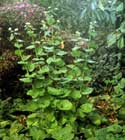 Alliaria petiolata. Hedge garlic. This native biennial plant can be found wild in many hedgerows so there is probably little need to cultivate it. The leaves, flowers and young seedpods have a flavour that is somewhat like a cross between garlic and mustard -fairly pleasant when added in small quantities to a salad. This is one of the more shade-tolerant plants on the list. If you decide to cultivate it then collect the seeds from wild plants in early summer and sow them straightaway in situ. They will normally maintain themselves by self-sowing.
Alliaria petiolata. Hedge garlic. This native biennial plant can be found wild in many hedgerows so there is probably little need to cultivate it. The leaves, flowers and young seedpods have a flavour that is somewhat like a cross between garlic and mustard -fairly pleasant when added in small quantities to a salad. This is one of the more shade-tolerant plants on the list. If you decide to cultivate it then collect the seeds from wild plants in early summer and sow them straightaway in situ. They will normally maintain themselves by self-sowing.
.jpg)
.jpg) Allium species. Onions, Chives etc. There are a number of species in this genus that can supply winter leaves. The British native wild garlic, A. ursinum, is a woodland plant. Usually available from late winter, the leaves and flowers have a delicious mild garlic flavour. An aggressive spreader, it is probably best left in the woodland, it is also more tolerant of wet soils than other plants in this list. The leaves of A. neapolitanum, the daffodil garlic, are available all through the winter and the plant produces beautiful white flowers in early spring. Both the leaves and the flowers have a garlic flavour and are delightful in salads. Whilst seed of this plant can be sown in the spring, best results will be obtained by sowing it in a greenhouse in early autumn. This species is only hardy milder areas. The perennial onion, A. cepa ‘Perutile’ is more reliable in colder areas - its mild onion flavoured leaves are available all year round. There are many other Allium species to choose from -the following should be hardy in most temperate regions. Welsh onions, A. fistulosum often die down in severe winters but will be back again in late winter. Chives, A. schoenoprasum, die down in early winter but are back in late winter too. The three-cornered leek, A. triquetrum can be available from autumn onwards and has naturalized in parts of Britain.
Allium species. Onions, Chives etc. There are a number of species in this genus that can supply winter leaves. The British native wild garlic, A. ursinum, is a woodland plant. Usually available from late winter, the leaves and flowers have a delicious mild garlic flavour. An aggressive spreader, it is probably best left in the woodland, it is also more tolerant of wet soils than other plants in this list. The leaves of A. neapolitanum, the daffodil garlic, are available all through the winter and the plant produces beautiful white flowers in early spring. Both the leaves and the flowers have a garlic flavour and are delightful in salads. Whilst seed of this plant can be sown in the spring, best results will be obtained by sowing it in a greenhouse in early autumn. This species is only hardy milder areas. The perennial onion, A. cepa ‘Perutile’ is more reliable in colder areas - its mild onion flavoured leaves are available all year round. There are many other Allium species to choose from -the following should be hardy in most temperate regions. Welsh onions, A. fistulosum often die down in severe winters but will be back again in late winter. Chives, A. schoenoprasum, die down in early winter but are back in late winter too. The three-cornered leek, A. triquetrum can be available from autumn onwards and has naturalized in parts of Britain.
 Atriplex halimus. The salt bush, is an evergreen shrub growing 1 metre or more tall. Very resistant to maritime exposure, it can be trimmed and grown as a hedge to provide shelter for other plants in the winter garden. The leaves are more silvery than green and have a distinctive salty flavour. It can be picked in moderation throughout the winter. It has become naturalized on the coasts of S. England but is not hardy in the colder areas of Britain. A. canescens is a very similar-looking N. American shrub that has the same uses.
Atriplex halimus. The salt bush, is an evergreen shrub growing 1 metre or more tall. Very resistant to maritime exposure, it can be trimmed and grown as a hedge to provide shelter for other plants in the winter garden. The leaves are more silvery than green and have a distinctive salty flavour. It can be picked in moderation throughout the winter. It has become naturalized on the coasts of S. England but is not hardy in the colder areas of Britain. A. canescens is a very similar-looking N. American shrub that has the same uses.
 Barbarea vulgaris. This plant is our native yellow rocket. A short-lived perennial growing about 30cm tall, it has a hot watercress-like flavour.
Barbarea vulgaris. This plant is our native yellow rocket. A short-lived perennial growing about 30cm tall, it has a hot watercress-like flavour.
It might die down in colder winters and usually self-sows when happy. B. verna, American land cress, is related to this plant and can also be grown for winter salads, though it is not reliably perennial and is normally sown in late summer or early autumn in order to provide winter leaves.
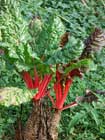 Beta vulgaris cicla is the cultivated spinach beet. Although it is a biennial, this plant usually self-sows freely and provides fresh leaves all year round with very little effort from the grower. The much more ornamental cultivar ‘Ruby Chard’ can also be used but it does not self-sow as freely, nor is it so hardy, often dying down in cold winters. A good salad leaf, but with a raw beetroot-like flavour that is not to everyone's taste.
Beta vulgaris cicla is the cultivated spinach beet. Although it is a biennial, this plant usually self-sows freely and provides fresh leaves all year round with very little effort from the grower. The much more ornamental cultivar ‘Ruby Chard’ can also be used but it does not self-sow as freely, nor is it so hardy, often dying down in cold winters. A good salad leaf, but with a raw beetroot-like flavour that is not to everyone's taste.
.jpg) Campanula poscharskyana
Campanula poscharskyana
C. poscharskyana is a lovely carpeting harebell (or bluebell if you live in Scotland). About 10 - 25cm tall, this is a rampantly spreading plant that makes good ground-cover. The leaves, although small, are a very nice mild salad and can be eaten all year round.
.jpg) Campanula versicolor. It is about 1.2 metres tall and flowers in late summer. The
Campanula versicolor. It is about 1.2 metres tall and flowers in late summer. The
plant keeps a basal rosette of leaves all winter and, although only growing slowly, it can be harvested in moderation all through the winter. The leaves have a delicious sweet flavour and are one of the more popular salad leaves. The plant is not hardy in the colder areas and is also popular with slugs.
 Cardamine hirsuta. Hairy bittercress is a common garden weed. The leaves have a hot cress-like flavour and, once you have the plant in your garden, it will normally self sow. The leaves are available all year round.
Cardamine hirsuta. Hairy bittercress is a common garden weed. The leaves have a hot cress-like flavour and, once you have the plant in your garden, it will normally self sow. The leaves are available all year round.
.jpg) Cichorium intybus. Chicory is a fairly well known salad plant. Although a perennial, it is best to sow the seed annually in late spring or early summer for winter leaves. Older plants tend to die down in the winter or only produce a very small basal rosette. It is important to choose the correct cultivars - ‘Sugar Loaf’ is one of the best. The leaves have a somewhat bitter taste that many people enjoy, they can be blanched to make them milder but this will be at the expense of many vitamins and minerals.
Cichorium intybus. Chicory is a fairly well known salad plant. Although a perennial, it is best to sow the seed annually in late spring or early summer for winter leaves. Older plants tend to die down in the winter or only produce a very small basal rosette. It is important to choose the correct cultivars - ‘Sugar Loaf’ is one of the best. The leaves have a somewhat bitter taste that many people enjoy, they can be blanched to make them milder but this will be at the expense of many vitamins and minerals.
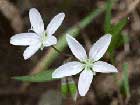 Claytonia virginica. Spring beauty is about 20cm tall and usually provides leaves throughout the winter. Both the leaves and the flowers can be eaten and have a fairly mild flavour. The taste is suggestive of raw beetroot, which not everybody enjoys.
Claytonia virginica. Spring beauty is about 20cm tall and usually provides leaves throughout the winter. Both the leaves and the flowers can be eaten and have a fairly mild flavour. The taste is suggestive of raw beetroot, which not everybody enjoys.
 Foeniculum vulgare. Very easy to grow, these fennel plants die down in mid-winter, but in mild areas start growing again almost immediately. In colder areas they will probably be somewhat later into growth. The leaves have an aniseed flavour. The plant is rather vigorous, growing about 1 metre tall and wide. It also self-sows freely.
Foeniculum vulgare. Very easy to grow, these fennel plants die down in mid-winter, but in mild areas start growing again almost immediately. In colder areas they will probably be somewhat later into growth. The leaves have an aniseed flavour. The plant is rather vigorous, growing about 1 metre tall and wide. It also self-sows freely.
.jpg) Montia sibirica / Claytonia sibirica. Pink purslane is a short-lived perennial, but it self-sows freely and maintains itself so well that it can be used as a ground cover plant. Only about 10cm tall, it is evergreen and both the leaves and flowers can be eaten. A fairly bland flavour, though it becomes somewhat bitter in hot dry weather. M. perfoliata, the miner’s lettuce, is an annual that self-sows freely and is also usually available all through the winter.
Montia sibirica / Claytonia sibirica. Pink purslane is a short-lived perennial, but it self-sows freely and maintains itself so well that it can be used as a ground cover plant. Only about 10cm tall, it is evergreen and both the leaves and flowers can be eaten. A fairly bland flavour, though it becomes somewhat bitter in hot dry weather. M. perfoliata, the miner’s lettuce, is an annual that self-sows freely and is also usually available all through the winter.
Both of these plants are extremely hardy, they are native to Alaska and Siberia where they can be harvested from under the snow even in the depths of winter.
 Myrrhis odorata. The British native Sweet Cicely has a delightful aniseed flavour and it goes very well as a flavouring in a mixed salad. It dies down in early winter but in mild areas it will grow again quickly and produce leaves even in mid-winter. The seed is said to have a short viability and is best sown as soon as it is ripe. A well-grown plant is about 1 metre tall and wide.
Myrrhis odorata. The British native Sweet Cicely has a delightful aniseed flavour and it goes very well as a flavouring in a mixed salad. It dies down in early winter but in mild areas it will grow again quickly and produce leaves even in mid-winter. The seed is said to have a short viability and is best sown as soon as it is ripe. A well-grown plant is about 1 metre tall and wide.
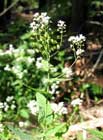 Peltaria alliacea. A very easily grown plant, it has a rather strong garlic/mustard flavour that some people adore in salads. It becomes much more bitter in the summer. An evergreen herb about 10cm tall it spreads freely once established.
Peltaria alliacea. A very easily grown plant, it has a rather strong garlic/mustard flavour that some people adore in salads. It becomes much more bitter in the summer. An evergreen herb about 10cm tall it spreads freely once established.
.jpg) Reichardia picroides. This plant looks somewhat similar to a dandelion but wait until you taste the leaves! Instead of the bitterness of a dandelion the leaves have a very acceptable flavour with a slight sweetness. They can be used in quantity in salads - far better than lettuce and so much easier to grow. It is one of the few plants we have where we like the leaves but the slugs don’t. It really has rave reviews and is incredibly productive - even when the plants are flowering the leaves maintain their delicious flavour.
Reichardia picroides. This plant looks somewhat similar to a dandelion but wait until you taste the leaves! Instead of the bitterness of a dandelion the leaves have a very acceptable flavour with a slight sweetness. They can be used in quantity in salads - far better than lettuce and so much easier to grow. It is one of the few plants we have where we like the leaves but the slugs don’t. It really has rave reviews and is incredibly productive - even when the plants are flowering the leaves maintain their delicious flavour.
 Rumex acetosa. Sorrel is an excellent salad plant. The leaves have a delicious lemon flavour, though they should not be eaten in quantity since they contain oxalic acid. Ken Fern has grown a very superior cultivar from Poland that virtually never flowers and provides large tasty leaves all the year round. Plants are about 40cm tall and spread slowly.
Rumex acetosa. Sorrel is an excellent salad plant. The leaves have a delicious lemon flavour, though they should not be eaten in quantity since they contain oxalic acid. Ken Fern has grown a very superior cultivar from Poland that virtually never flowers and provides large tasty leaves all the year round. Plants are about 40cm tall and spread slowly.
 Rumex alpinus. Unlike other docks, the leaves of the alpine dock make a fairly acceptable addition to winter salads (and a delicious spinach substitute). The plant stays green all winter if the weather is mild, otherwise it will die down but reappear in late winter. The leaves become bitterer in the summer but are still acceptable cooked. A very vigorous plant, growing about 60cm tall and wide.
Rumex alpinus. Unlike other docks, the leaves of the alpine dock make a fairly acceptable addition to winter salads (and a delicious spinach substitute). The plant stays green all winter if the weather is mild, otherwise it will die down but reappear in late winter. The leaves become bitterer in the summer but are still acceptable cooked. A very vigorous plant, growing about 60cm tall and wide.
 Sanguisorba minor. Salad burnet is an evergreen British native plant that is sometimes cultivated for its edible leaves. Very easy to grow and often self-sowing freely, the leaves can be eaten all year round and some people claim that they have the flavour of cucumbers, but not everyone likes them. Plants are about 50cm tall when flowering and 30cm wide.
Sanguisorba minor. Salad burnet is an evergreen British native plant that is sometimes cultivated for its edible leaves. Very easy to grow and often self-sowing freely, the leaves can be eaten all year round and some people claim that they have the flavour of cucumbers, but not everyone likes them. Plants are about 50cm tall when flowering and 30cm wide.
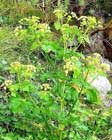 Smyrnium olusatrum. Alexanders grows wild in hedgerows in many parts of Britain and does not really need to be cultivated. The leaves have a strong celery-like flavour and are not to everyone’s taste. A biennial, it grows about 1 metre tall and self-sows freely if given a suitable position.
Smyrnium olusatrum. Alexanders grows wild in hedgerows in many parts of Britain and does not really need to be cultivated. The leaves have a strong celery-like flavour and are not to everyone’s taste. A biennial, it grows about 1 metre tall and self-sows freely if given a suitable position.
.jpg) Taraxacum officinale. Nutritionally very valuable, many people find dandelions too bitter for salads. However, the winter leaves are less bitter and a few leaves added to a chopped salad will hardly be noticed. There are also some cultivated forms that are said to have nicer tasting leaves, but you may not notice the difference. The seed can be obtained from some of the larger seed catalogues. We find it easier to grow this plant in the lawn - if you let the grass grow a little longer in the winter it will protect the dandelions and they will then be more productive as well as more tender. There are also a number of dandelion look-alikes that can be found growing in gardens and hedgerows in the winter.
Taraxacum officinale. Nutritionally very valuable, many people find dandelions too bitter for salads. However, the winter leaves are less bitter and a few leaves added to a chopped salad will hardly be noticed. There are also some cultivated forms that are said to have nicer tasting leaves, but you may not notice the difference. The seed can be obtained from some of the larger seed catalogues. We find it easier to grow this plant in the lawn - if you let the grass grow a little longer in the winter it will protect the dandelions and they will then be more productive as well as more tender. There are also a number of dandelion look-alikes that can be found growing in gardens and hedgerows in the winter.
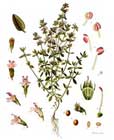 Thymus vulgaris. The garden thyme is a dwarf evergreen shrub, usually less than 30cm tall. T. Vulgaris is an excellent addition to salads adding a delightful fragrance. It has also been shown that eating thyme daily can prolong active life.
Thymus vulgaris. The garden thyme is a dwarf evergreen shrub, usually less than 30cm tall. T. Vulgaris is an excellent addition to salads adding a delightful fragrance. It has also been shown that eating thyme daily can prolong active life.
 Valerianella locusta.
Valerianella locusta.
Corn salad is a British native annual that is sometimes cultivated for its mild-tasting leaves. If allowed to flower it will usually self-sow and can then be available all year round.
Viola odorata. Sweet violets are about 10cm tall and come into flower in the depths of winter. Both the leaves and the flowers can be added to salads, they have a fairly bland flavour, the flowers doing wonders to brighten up winter salads. .jpg)
Database
The database has more details on these plants: Alliaria petiolata, Atriplex halimus, Barbarea verna, Barbarea vulgaris, Beta vulgaris cicla, Campanula poscharskyana, Campanula versicolor, Cardamine hirsuta, Cichorium intybus, Claytonia virginica, Foeniculum vulgare, Montia perfoliata, Myrrhis odorata, Peltaria alliacea, Reichardia picroides, Rumex acetosa, Rumex alpinus, Sanguisorba minor, Smyrnium olusatrum, Taraxacum officinale, Thymus vulgaris, Valerianella locusta, Viola odorata.